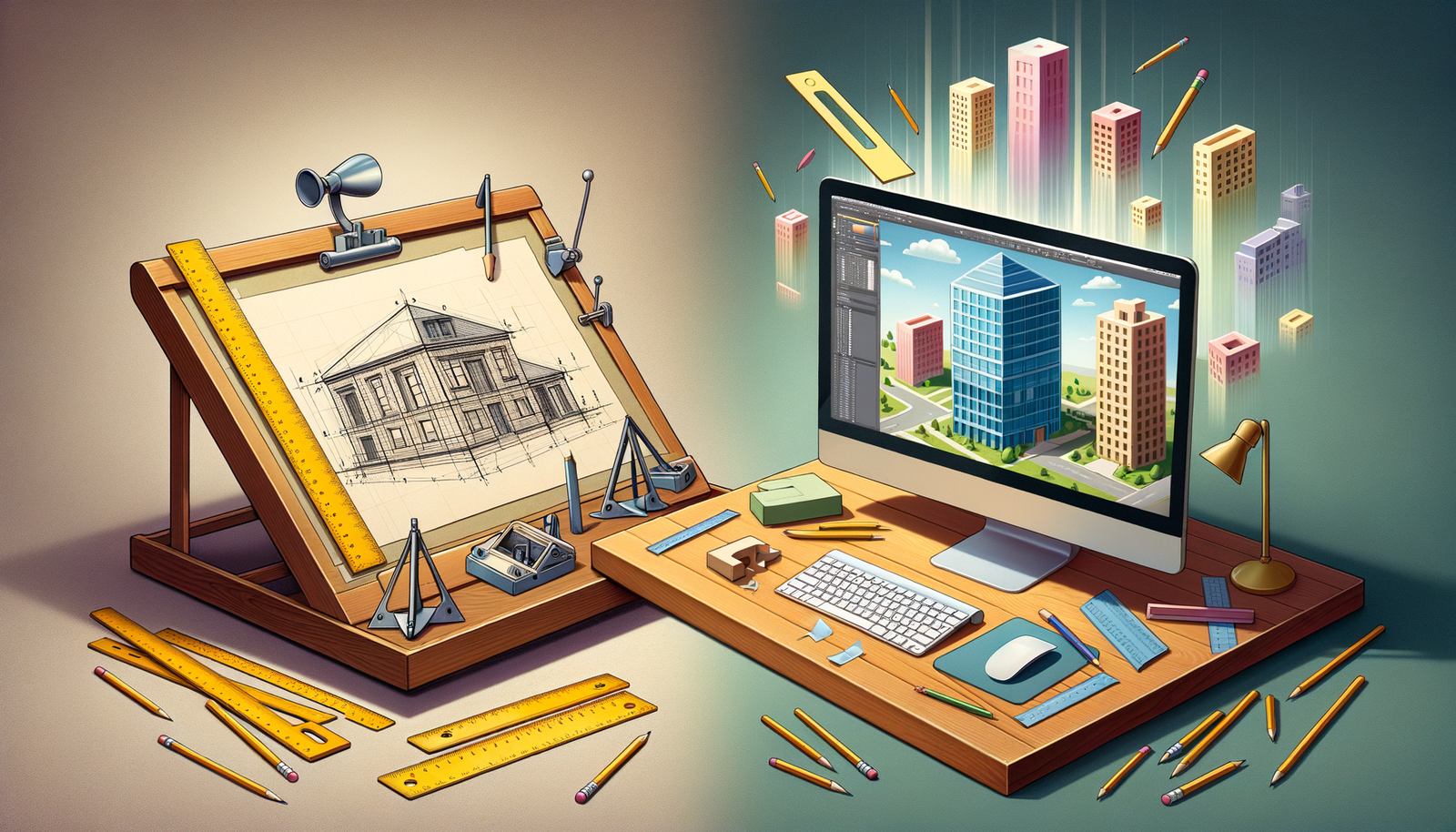Your Cart is Empty
Customer Testimonials
-
"Great customer service. The folks at Novedge were super helpful in navigating a somewhat complicated order including software upgrades and serial numbers in various stages of inactivity. They were friendly and helpful throughout the process.."
Ruben Ruckmark
"Quick & very helpful. We have been using Novedge for years and are very happy with their quick service when we need to make a purchase and excellent support resolving any issues."
Will Woodson
"Scott is the best. He reminds me about subscriptions dates, guides me in the correct direction for updates. He always responds promptly to me. He is literally the reason I continue to work with Novedge and will do so in the future."
Edward Mchugh
"Calvin Lok is “the man”. After my purchase of Sketchup 2021, he called me and provided step-by-step instructions to ease me through difficulties I was having with the setup of my new software."
Mike Borzage
Design Software History: The Evolution from 2D Drafting to 3D Modeling: Key Innovations and Industry Impact
September 18, 2024 6 min read


The Transition from 2D Drafting to 3D Modeling
Origins and Early Days of 2D Drafting
Historical Context
Before the advent of computer-aided design (CAD), traditional drafting techniques were the cornerstone of engineering and architectural design. Skilled draftsmen meticulously created detailed plans and blueprints by hand, using tools such as T-squares, compasses, and drafting machines. This manual process was not only time-consuming but also prone to human error, making the revision and correction of designs a cumbersome task.
The limitations and challenges of manual drafting were numerous. Reproducing designs required specialized equipment, and any changes to the design meant redrawing the entire blueprint from scratch. Additionally, the accuracy of hand-drawn plans was often compromised, leading to potential discrepancies in the final product. These challenges underscored the need for a more efficient and precise method of design documentation.
Early CAD Systems
The development of the first CAD software in the 1960s marked a revolutionary shift in the design industry. Companies like IBM and General Motors were at the forefront of these early efforts, recognizing the potential of computers to streamline the design process. One of the earliest and most significant developments was Ivan Sutherland’s Sketchpad, which he introduced in 1963 as part of his PhD thesis at MIT.
Sketchpad was groundbreaking; it allowed designers to create and manipulate graphical objects directly on a computer screen using a light pen. This innovation laid the foundation for future CAD systems by demonstrating the feasibility and advantages of electronic design over manual drafting. Sketchpad's influence extended beyond CAD, inspiring future generations of computer graphics and interactive computing.
Key Figures and Companies
Among the key figures in the evolution of CAD was John Walker, who, along with a team of programmers, developed AutoCAD in the early 1980s. Founded in 1982, Autodesk rapidly emerged as a major player in the CAD industry. AutoCAD was revolutionary because it brought CAD capabilities to personal computers, making it more accessible to a broader audience of engineers, architects, and designers.
The rise of Autodesk and its flagship product, AutoCAD, democratized the use of CAD, transitioning it from an expensive, specialized tool used by large corporations to a more ubiquitous utility. This democratization played a crucial role in the widespread adoption of CAD across various industries, setting the stage for further technological advancements.
The Shift to 3D Modeling
Technological Innovations
The introduction of solid modeling in the 1980s marked a significant evolution in CAD technology. Unlike 2D drafting, which represented objects using flat, two-dimensional views, solid modeling allowed designers to create and manipulate three-dimensional representations of objects. This advancement provided a more accurate and comprehensive way to visualize and analyze designs.
Parametric and feature-based modeling techniques further revolutionized 3D CAD by allowing designers to define models through parameters and features rather than just geometric shapes. Pioneers like Pierre Bézier contributed significantly to these advancements with the development of Bézier curves, which enabled smoother and more flexible geometric modeling. Bézier curves became a fundamental tool in CAD, underpinning the design of complex shapes and surfaces.
Software Milestones
The launch of PTC's Pro/ENGINEER in 1988 was a milestone in the transition to 3D modeling. Pro/ENGINEER introduced parametric, feature-based modeling, which allowed for the easy modification and optimization of designs. This software became widely adopted in industries such as automotive and aerospace, where precision and efficiency were paramount.
Another significant development was the creation of Dassault Systèmes' CATIA. Initially developed for the French aircraft manufacturer Dassault Aviation, CATIA quickly became a leading CAD system in industries like aerospace and automotive due to its robust capabilities in 3D modeling and simulation. CATIA's impact on these industries was profound, facilitating the design and manufacturing of complex products with unprecedented accuracy and efficiency.
In the mid-1990s, the emergence of SolidWorks played a crucial role in democratizing 3D CAD. Unlike earlier, more expensive systems, SolidWorks was designed to be user-friendly and affordable, making advanced 3D modeling accessible to small and medium-sized enterprises. This broadened the scope of 3D CAD usage and accelerated its adoption across various sectors.
Challenges in Transition
The shift from 2D drafting to 3D modeling was not without its challenges. Many engineers and designers who were accustomed to traditional 2D drafting techniques were resistant to adopting the new 3D technologies. The initial learning curve was steep, and early 3D modeling software often required significant computational resources, which were not readily available to all users.
Over time, however, the benefits of 3D modeling—such as improved visualization, error detection, and the ability to perform simulations—became increasingly apparent. As software became more user-friendly and computational power increased, the transition to 3D modeling accelerated, ultimately transforming the design landscape.
Impact on Design Processes and Industries
Enhanced Design Capabilities
The transition to 3D modeling has significantly enhanced design capabilities across various industries. One of the key advantages of 3D modeling is the improved visualization of designs. Unlike 2D drawings, which can be difficult to interpret, 3D models provide a comprehensive view of the object from multiple angles, making it easier to understand and analyze the design.
Additionally, 3D modeling allows for better error detection and correction. Designers can perform simulations and analyses directly within the CAD environment, identifying potential issues and making necessary adjustments early in the design process. This reduces the likelihood of costly errors and rework during manufacturing.
Industries such as automotive, aerospace, and consumer electronics have been particularly transformed by 3D modeling. In the automotive industry, for example, 3D CAD software enables designers to create detailed models of car components, perform aerodynamic simulations, and optimize designs for performance and safety. Similarly, in aerospace, 3D modeling facilitates the design of complex aircraft structures, enhancing both efficiency and precision.
Educational Shift
The rise of 3D modeling has also led to significant changes in engineering and design education. Traditional curricula, which focused primarily on 2D drafting techniques, have evolved to include comprehensive training in 3D CAD. Educational institutions now emphasize the importance of 3D modeling skills, preparing students for the demands of modern design and engineering roles.
Furthermore, companies like Dassault Systèmes and Autodesk offer training programs and certifications in their respective CAD software. These programs provide designers and engineers with the skills and knowledge needed to effectively use advanced 3D modeling tools, ensuring a workforce that is well-equipped to leverage the benefits of modern CAD technologies.
Modern Trends and Future Directions
Current State of 3D Modeling
Today, 3D modeling is an integral part of the design process in many industries. The integration of 3D modeling with other technologies, such as virtual reality (VR) and augmented reality (AR), has further enhanced its capabilities. These technologies enable designers to immerse themselves in virtual environments, providing a more intuitive and interactive way to explore and refine their designs.
Cloud-based CAD solutions, such as Autodesk Fusion 360 and Onshape, have also emerged, offering greater flexibility and collaboration. These platforms allow designers to work on their models from anywhere, collaborate with team members in real-time, and access powerful computational resources without the need for high-end hardware. The cloud-based approach has democratized access to advanced CAD tools, making them available to a broader audience.
Future Innovations
The future of 3D modeling holds exciting possibilities, particularly with the advancements in artificial intelligence (AI) and machine learning. These technologies have the potential to automate and optimize design processes, enabling designers to focus on more creative and strategic aspects of their work. AI-powered tools can analyze vast amounts of data, identify patterns, and suggest design improvements, leading to more efficient and innovative solutions.
In addition to AI, advances in additive manufacturing are shaping the future of 3D modeling. 3D printing software is becoming increasingly sophisticated, enabling the creation of complex, customized products with unprecedented precision. As additive manufacturing continues to evolve, the integration of 3D modeling and 3D printing will play a crucial role in the development of new products and technologies.
Ongoing Challenges
Despite the significant advancements in 3D modeling, ongoing challenges remain. One of the primary challenges is bridging the gap between advanced software capabilities and user proficiency. While modern CAD tools offer powerful features, effectively utilizing these tools requires a high level of expertise and continuous learning. Ensuring that designers and engineers are adequately trained and proficient in using these technologies is essential for maximizing their potential.
Another challenge is the need for continuous adaptation to emerging technologies and market demands. The rapid pace of technological innovation means that design professionals must stay up-to-date with the latest tools and techniques. This requires a commitment to lifelong learning and professional development, as well as a willingness to embrace new ways of working.
Conclusion
The transition from 2D drafting to 3D modeling has been a transformative journey in the history of design software. The adoption of 3D modeling has revolutionized design processes, enhancing visualization, error detection, and overall efficiency. Industries such as automotive, aerospace, and consumer electronics have benefited immensely from the capabilities of 3D CAD.
Looking ahead, the future of 3D modeling promises continued innovation, with AI, machine learning, and additive manufacturing leading the way. As these technologies evolve, they will further enhance the design process, enabling the creation of more sophisticated and customized products. However, ongoing challenges, such as ensuring user proficiency and adapting to new technologies, must be addressed to fully realize the potential of 3D modeling.
Ultimately, the importance of 3D modeling in modern design cannot be overstated. It has fundamentally changed the way we approach design and engineering, providing powerful tools that drive innovation and efficiency. As we continue to explore new frontiers in design software, the legacy of 3D modeling will undoubtedly shape the future of design for years to come.
Also in Design News

Rhino 3D Tip: AOV-Based Render Pass Workflow for Rapid, Non‑Destructive Compositing
December 28, 2025 2 min read
Read More
Cinema 4D Tip: Consolidate Geometry with Connect Objects + Delete
December 28, 2025 2 min read
Read More
V-Ray Tip: Region Rendering Best Practices for Fast, Seamless Comp Patches
December 28, 2025 2 min read
Read MoreSubscribe
Sign up to get the latest on sales, new releases and more …


